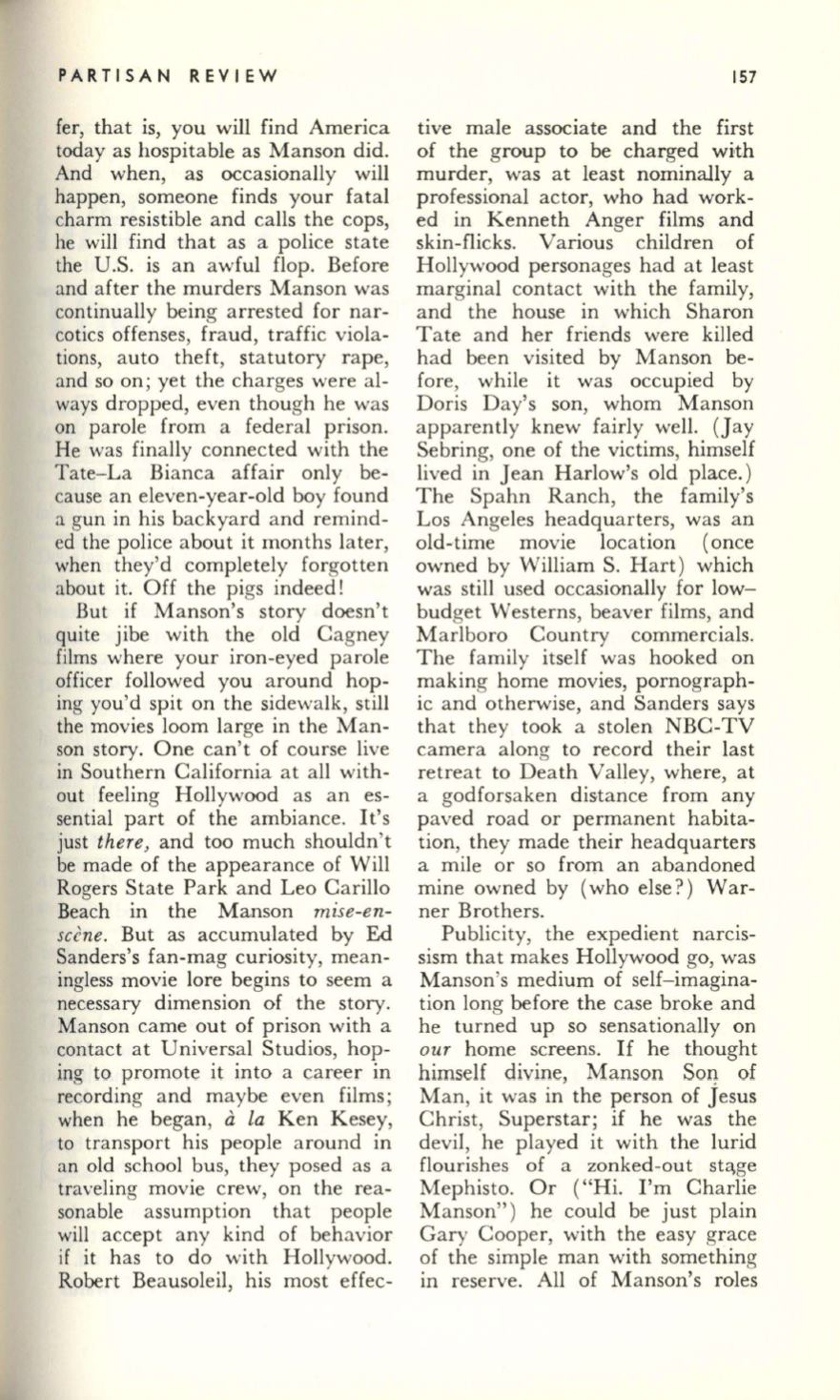
PARTISAN REVIEW
fer, that is, you will find America
today as hospitable as Manson did.
And when, as occasionally will
happen, someone finds your fatal
charm resistible and calls the cops,
he will find that as a police state
the U.S. is an awful flop. Before
and after the murders Manson was
continually being arrested for nar–
cotics offenses, fraud, traffic viola–
tions, auto theft, statutory rape,
and so on; yet the charges were al–
ways dropped, even though he was
on parole from a federal prison.
He was fina lly connected with the
Tate-La Bianca affair only be–
cause an eleven-year-old boy found
a gun in his backyard and remind–
ed the police about it months later,
when they'd completely forgotten
about it. Off the pigs indeed!
But if Manson's story doesn't
quite jibe with the old Cagney
films where your iron-eyed parole
officer followed you around hop–
ing you'd spit on the sidewalk, still
the movies loom large in the Man–
son story. One can't of course live
in Southern California at all with–
out feeling Hollywood as an es–
sential part of the ambiance. It's
just
there,
and too much shouldn't
be made of the appearance of Will
Rogers State Park and Leo Carillo
Beach in the Manson
mise-en–
scene.
But as accumulated by Ed
Sanders's fan-mag curiosity, mean–
ingless movie lore begins to seem a
necessary dimension of the story.
Manson came out of prison with a
contact at Universal Studios, hop–
ing to promote it into a career in
recording and maybe even films;
when he began, d
la
Ken Kesey,
to transport his people around in
an old school bus, they posed as a
traveling movie crew, on the rea–
sonable assumption that people
will accept any kind of behavior
if it has to do with Hollywood.
Robert Beausoleil, his most effec-
157
tive male associate and the first
of the group to be charged wi,th
murder, was at least nominally a
professional actor, who had work–
ed in Kenneth Anger films and
skin-flicks. Various children of
Hollywood personages had at least
marginal contact with the family,
and the house in which Sharon
T ate and her friends were killed
had been visited by Manson be–
fore , while it was occupied by
Doris Day's son, whom Manson
apparently knew fairly well. (Jay
Sebring, one of the victims, himself
lived in Jean Harlow's old place.)
The Spahn Ranch, the family's
Los Angeles headquarters, was an
old-·time movie location (once
owned by William S. H art ) which
was still used occasionally for low–
budget Westerns, beaver films, and
Ma rlboro Country commercials.
The family itself was hooked on
making home movies, pornograph–
ic and otherwise, and Sanders says
that they took a stolen NBC-TV
camera along to record their last
retreat to Death Valley, where, at
a godforsaken
di~tance
from any
paved road or permanent habita–
tion, they made their headquarters
a mile or so from an abandoned
mine owned by (who else?) War–
ner Brothers.
Publicity, the expedient narcis–
sism that makes Hollywood go, was
Manson's medium of self-imagina–
tion long before the case broke and
he turned up so sensationally on
OUT
home screens.
If
he thought
himself divine, Manson Son of
Man, it was in the person of jesus
Christ, Superstar; if he was the
devil, he played it with the lurid
flourishes of a zonked-out stage
Mephisto. Or ("Hi. I'm Charlie
Manson" ) he could be just plain
Gary Cooper, with the easy grace
of the simple man with something
in reserve. All of Manson's roles


